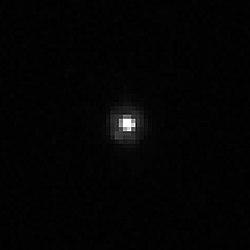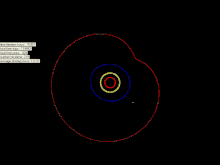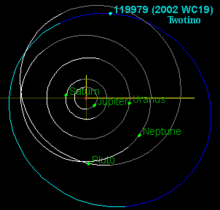 2002 WC19 and its satellite imaged by the Hubble Space Telescope in 2007 | |
| Discovery | |
|---|---|
| Discovered by | Palomar Observatory |
| Discovery date | 16 November 2002 |
| Designations | |
MPC designation | (119979) 2002 WC19 |
| Twotino[1][2] binary | |
| Orbital characteristics[5] | |
| Epoch 13 January 2016 (JD 2457400.5) | |
| Uncertainty parameter 3 | |
| Observation arc | 3978 days (10.89 yr) |
| Aphelion | 60.732 AU (9.0854 Tm) |
| Perihelion | 35.289 AU (5.2792 Tm) |
Semi-major axis | 48.010 AU (7.1822 Tm) |
| Eccentricity | 0.26498 |
| 332.67 yr (121,507 d) | |
| 316.02° | |
| 0° 0m 10.666s / day | |
| Inclination | 9.1746° |
| 109.7547° | |
| ≈ 5 November 2056[3] ±3 days | |
| 44.356° | |
| Known satellites | 1 (81 km)[4] |
| Earth MOID | 34.3056 AU (5.13204 Tm) |
| Jupiter MOID | 29.9229 AU (4.47640 Tm) |
| Physical characteristics | |
| Dimensions | 338 km[4] |
| Mass | (7.7±0.5)×1019 kg[4] |
Mean density | 1.97 g/cm3[4] |
| 0.07 (expected from theory)[6] | |
| 4.9 | |
(119979) 2002 WC19 is a twotino, that is, a planetoid in a 1:2 orbital resonance with Neptune. It was discovered on November 16, 2002 at the Palomar Observatory. It is probably a dwarf planet in Brown's estimation,[6] but is likely much too small to be a solid body.
Knowing how many twotinos there are may reveal whether Neptune took roughly 1 million or 10 million years to migrate about 7 AU from its birth location.[7]

Satellite
A natural satellite was reported to be orbiting (119979) 2002 WC19 on February 27, 2007. It is estimated to be 4092±94 km from the primary, with an orbital period of 8.403±0.001 days, an eccentricity of 0.21±0.05 and an inclination of 24.0°±0.7°. Assuming similar albedos, it is a quarter the diameter of its primary, or around 81 kilometres (50 mi) in diameter.[4]
References
- ^ Marc W. Buie (2004-12-14). "Orbit Fit and Astrometric record for 119979". (using 61 of 65 observations) SwRI (Space Science Department). Retrieved 2009-03-04.
- ^ "MPEC 2009-C70 :Distant Minor Planets (2009 February 28.0 TT)". Minor Planet Center. 2009-02-10. Retrieved 2009-03-04.
- ^ JPL Horizons Observer Location: @sun (Perihelion occurs when deldot changes from negative to positive. Uncertainty in time of perihelion is 3-sigma.)
- ^ a b c d e Wm. Robert Johnston (27 May 2019). "(119979) 2002 WC19". Johnston's Archive. Retrieved 2020-10-16.
- ^ "JPL Small-Body Database Browser: 119979 (2002 WC19)" (2012-11-06 last obs; arc: 10.89 years). Retrieved 7 April 2016.
- ^ a b Mike Brown, How many dwarf planets are there in the outer solar system? Archived October 18, 2011, at the Wayback Machine
- ^ Ron Cowen (2009-01-04). "On the Fringe". ScienceNews. Archived from the original on 7 January 2010. Retrieved 2010-01-04.
External links
- (119979) 2002 WC19 at the JPL Small-Body Database
